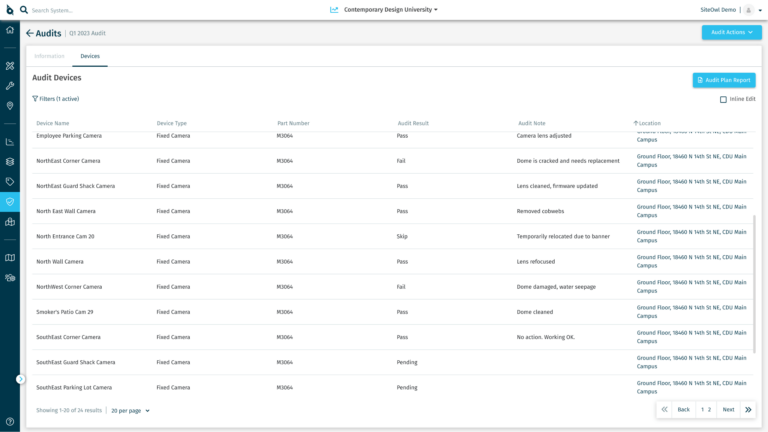Part four of our five-part series discussing SiteOwl’s Lifecycle Management Framework.
What’s a state-of-the-art facility without a security system? It’s just a building.
If you’re a security director or physical security manager, you know firsthand the amount of time and effort that goes into the design, implementation, and maintenance of your physical security systems.
In this article, we’ll share five key steps to help you optimize your physical security maintenance program.
Table of Contents
- Perform a Comprehensive Assessment
- Inventory your physical security assets
- Establish a Preventive Maintenance Schedule
- Empower your security team with the right tools
- Conduct periodic security audits
1. Perform a Comprehensive Assessment
A comprehensive assessment is the first step to ensuring your security system is operating as designed and meeting your needs. Security systems include on-site video surveillance systems (CCTV), access control systems, intrusion detection systems, and other security-related technologies that are used to protect people and property.
Before starting any major maintenance work, a good starting point is to assess your security systems thoroughly. This will help you evaluate your security technology and how it fits into your physical security program.
Here are some things your assessment should include
- Vulnerability Assessment to identify any weak points in your security infrastructure. Typically this includes a perimeter assessment reviewing your current security measures, plans, and procedures.
-
System functionality evaluation to make sure each component is performing as expected. This can include reviewing system functionality, lifecycle, and maintenance history.
- Operational analysis to assess how your systems are being used and identify any opportunities to increase efficiency. Often, a security director may rely on security personnel or security guards to identify system issues, but without a central source of information, it’s difficult to track and prioritize issues.
Once you identify issues, it’s easier to plan how to fix them. If you need help getting started, feel free to download our free Physical Security Lifecycle Assessment template to help guide you through the process.
Download – Free Security Risk Self-Assessment Document
2. Inventory your physical security assets
Since you can’t maintain what you don’t know you have, obtaining an accurate inventory of your physical security assets is just as important as completing a security assessment.
It’s a good practice to have security policies and procedures in place that cover all aspects of your physical security program, including your inventory.
Asset inventory sounds basic, but without the right processes, it can quickly become daunting. Remote locations, legacy systems, and information gaps can all make asset inventory a security nightmare.
Navigating through facilities, gathering information, and tracking down the exact locations of your devices are major challenges if you don’t have access to an accurate floor plan to use as a reference. If your paper-based floor plan is years old, there’s no saying how accurate it is. You’ll want a digital floorplan that can be updated in real-time, not spreadsheets and CAD drawings that are out-of-date..
Centralization and Digitization
Maintaining all of your security asset information in a central location can save you hours of time and effort when planning your maintenance tasks. Centralization also provides a cost-effective way to implement security standards and special security requirements across your organization.
For example, if you have a system in one building that requires a physical security device, it’s a simple matter to duplicate that device in other locations. With SiteOwl, you can manage your asset inventory on digital floorplans that are accessible from anywhere. What’s more,you can also:
- Conduct system-wide audits to identify and fix security gaps surveillance systems.
- Add new devices to floor plans and store the location of each device, even when it is moved
- Track and manage all your system devices across multiple locations
- Stay on top of ongoing security system deployments and maintenance work in real-time
With a good understanding of what assets are available to you, you can build processes and policies to support your security strategy.
3. Establish a Preventive Maintenance Schedule
A preventive maintenance schedule will help you proactively address potential issues before they become major problems. Although your security needs will change over time, a good maintenance schedule will help you stay proactive.
For example, if you have sensitive areas in your facility, you may want to schedule maintenance on your security system at night. You may also want to focus on restricted areas and perimeter entry points during specific times of the year to ensure the right security controls are in place.
Your schedule should include regular inspections, testing, and cleaning of all components, as well as a plan for addressing any necessary repairs or upgrades. Some organizations fully inspect their systems every six months, while others do so yearly or when a system component fails.
For example, data centers that house mission-critical systems may need to perform daily inspections to comply with regulations. In comparison, commercial buildings may only need to perform periodic checks for fire alarm systems and other life safety devices.
In any case, it’s important to establish a schedule that works for your organization and will put your security team in the best position to support your security plan and risk management efforts.
There are many advantages of using a cloud-based platform to manage your preventive maintenance activities. For instance, you can:
- Schedule preventive maintenance tasks across multiple sites and devices from a single, centralized platform.
- Track and monitor the status of tasks in real-time from any device, anywhere.
- Monitor the lifecycle of devices and components to determine when they are due for replacement.
- Manage the cost of preventive maintenance by scheduling tasks based on current inventory levels.
- Schedule preventive maintenance tasks based on the equipment’s age, usage, and other factors.
With a solid schedule in place, your security team can focus on other priorities, such as preparing for incidents and addressing emerging threats.
SiteOwl can help your team plan and carry out maintenance audits from a central location. What’s more, your team can add notes at each device level, making it easy for you to get the right level of detail you want.
Download ebook – Managing the Lifecycle of Physical Security Systems
4. Empower your security team with the right tools
Detailed assessments, accurate inventories, and robust schedules are all great ways to optimize your preventive maintenance program, but they are only valuable if your team is empowered to make the most of them.
What are the right tools?
You want your team to have the information and resources to make informed decisions and take action. Most of all, you want to develop a culture that supports preventive maintenance. From how a ticket is generated to how resolutions are communicated, maintenance is a team effort.
But some of these challenges can slow your team down:
- Lack of visibility into maintenance status.
- Inability to identify trends in equipment failure.
- Information silos and lack of communication across teams.
- Escorting vendors and contractors to perform maintenance on equipment.
Leverage the power of the cloud to optimize your physical security operations
Imagine the following scenario: you’re a physical security manager responsible for a large campus with hundreds of access points and security cameras, and you get a call from an integrator asking you where a device is located. Not exactly a pleasant conversation when time is of the essence.
Now imagine this: your team is able to access an app on their mobile phone that shows the exact location of the device in real-time. Your team the device’s location, and you can quickly send the integrator the information needed to get the device up and running. Game changer!
5. Conduct periodic security audits
Conduct regular security audits to enhance the effectiveness of your physical security system. This will help you and your team identify emerging vulnerabilities and adjust your preventive maintenance schedule.
Audits could involve reviewing access control policies, assessing the effectiveness of surveillance cameras, and evaluating response procedures during a security incident. Based on your audit findings, you can decide if additional training or upgrades are necessary.
System Audit and Maintenance
In the past, conducting system-wide audits was time-consuming. With SiteOwl, you can improve the effectiveness of your security practice by
- Creating a centralized, secure repository of all the information related to your maintenance program.
- Automating routine tasks that would otherwise take up a significant amount of time.
- Providing real-time data and analytics to monitor performance and identify areas for improvement.
- Improving the quality of the information and the decision-making process.
- Conducting system-wide audits to identify and fix security gaps
Conclusion
Maintaining physical security systems is crucial to an effective preventive maintenance program. The steps in this article can help your team better plan and carry out maintenance activities.
Want to learn more? Download our free eBook: Managing The Lifecycle Of Physical Security Systems, a practical guide for enterprise security teams to plan, deploy, and manage security systems with confidence!

Su Subburaj
Su is SiteOwl's CMO and leads all marketing and communications. Su has extensive strategy and management consulting experience and previously consulted for 3Sixty Integrated where she gained an in-depth understanding of digital transformation challenges in the physical security industry. When not working on strategies to expand SiteOwl's footprint, Su enjoys bad karaoke, weightlifting and traveling.






